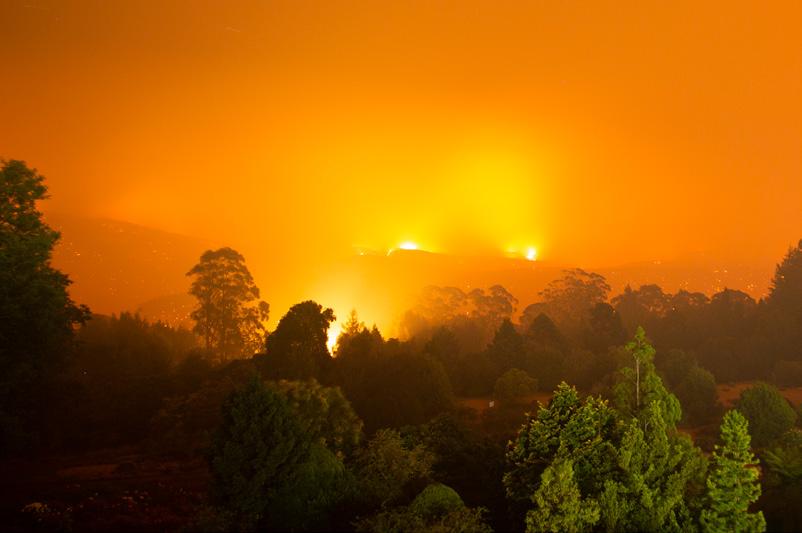
4 minute read
The Blue Mountains Botanic Garden Mount Tomah Recovery
Fire tore through this part of the conservation area (see opposite)
Advertisement
RISING FROM THE ASHES
AS THE BLUE MOUNTAINS BOTANIC GARDEN BEGINS ITS RECOVERY FROM BUSHFIRE, THE TEAM’S ASSESSMENTS OF THE SITUATION ARE PROVIDING VALUABLE INSIGHTS INTO THE IMPACT OF FIRE ON BOTANICAL COLLECTIONS
The bushfires that ravaged the east coast last summer seem like a distant memory for many, yet for the team at the Blue Mountains Botanic Garden, reminders surround us as we work to restore this beautiful space to its former glory.
As soon as all the fires had been extinguished and the basalt rocks had cooled among the ash, we were busy planning the recovery effort. We needed to assess trees, make areas safe, and repair or replace essential infrastructure. The staff were also needing support, and stories from the community needed to be heard.
Our neighbours in Mount Tomah, some of whom lost their properties, were also busy with their own journey of recovery. We had a team of highly qualified horticulturists, arborists and scientists on standby to help.
The Garden is, first and foremost, a horticultural and scientific institution, which makes our endeavour to recover the natural landscapes and ornamental gardens a bit different from many other organisations impacted by bushfires. We manage and care for a vast Living Collection of rare plants from around the world, as well as 250ha of World Heritage wilderness in the conservation area surrounding the main Garden.
The team has meticulous records on every plant in the collection, not just for posterity, but also for scientific research and to improve the global knowledge base for each species in our care. Our conservation area is an essential piece of high-quality wilderness that can be studied to a level not possible in the protected national parks.
ESSENTIAL RESEARCH With 90 per cent of the conservation area burnt, and thousands of Living Collection specimens directly impacted by the fire, we needed to embark on research to better understand exactly what happened and how the plants would respond. While there was an abundance of academic research, and methods for assessing bushfire
impacts on natural vegetation, there was almost nothing relating to impacts of bushfire on botanical collections.
We treated the assessments of the Living Collection and the natural bush very differently, and our plan was to assess the conservation area first, so we could then refine our methods for evaluating the collection.
Firstly, we needed to determine the varying intensities of the fire in different areas so we could assess the impacts those fire types had on individual species and the array of ecological plant communities found across the estate. Whether the fire had been an intensely hot canopy fire or a cooler trickle burn is the single most significant factor affecting individual species and ecological recovery.
Luckily, we have a wide network of experts to call upon. Our involvement in the Wollemi Pine Recovery Plan enabled our horticulturists to begin discussions with the team of scientists tasked with assessing wild populations of the ancient trees straightaway.
The first phase of assessing the impacts on the natural areas is now complete, and we have established monitoring plots across the estate in each ecological community to observe individual species recovery and the changes in plant diversity. Soon we will have an extremely valuable dataset to analyse, and to inform our final report.
We are three-quarters of the way through assessing every single plant in the Living Collection that was burnt or scorched. We don’t yet know the total number of losses, but have recorded interesting observations on several North American tree species that we didn’t know could re-sprout after fire.
GLOBAL SUPPORT While it is heartbreaking to lose any plant in the collection, there is a silver lining. As we confirm what has been lost, we have been inundated with offers of plant material from around the globe. Curator Manager Greg Bourke is in discussions with Botanic Gardens Conservation International (BGCI) to coordinate replacing the losses and strengthening our Living Collection. We will update you on the Garden’s progress in future editions. Ian Allan, Supervisor Ornamental Gardens
The conservation area alight

Force of nature

Burnt pedestrian bridge


Dry Hire Done Right: Every Site. Every Time.
Wide range of equipment and attachments


Available 24/7
Reliable equipment 100% Compliant All paperwork taken care of
1300 SP HIRE | SOLUTIONPLANTHIRE.COM.AU
FIVE GENERATIONS OF TYRRELL FAMILY WINEMAKING
PROUDLY SUPPORTING THE ROYAL BOTANIC GARDEN SYDNEY AND FOUNDATION & FRIENDS OF THE BOTANIC GARDENS












